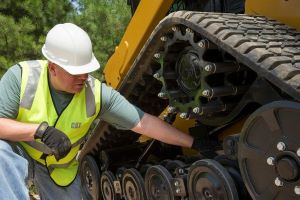Skid Steers, also referred to as compact track loaders, are a great piece of equipment when used properly. A critical component of these wonderful machines is their rubber tracks. Proper maintenance of skid steer tracks is a crucial component of ensuring optimal performance, getting the most life out of your rubber track and preventing costly repairs.
Apply the Correct Rubber Tracks
Getting the most life out of your rubber tracks starts with installing ones that are the right fit for your equipment as well as the correct tread pattern for the terrain that you will be operating on. Make sure that the skid steer tracks have the correct pitch and length to match the sprockets on your machine. Installing the incorrect tracks will cause premature wear on the gears and the tracks themselves.
Conduct regular inspections
A key step to maintaining your rubber tracks is doing daily and monthly inspections. Before and after each use, the operator should conduct a walk-around inspection looking for leaking, missing or damaged components. Take a few extra minutes to check the main parts of the undercarriage and rubber tracks can reduce expenses in the future.
Undercarriage Maintenance
Regular inspections of your undercarriage components will not only extend the life of your machine, but it will directly impact the life of your rubber track. While inspecting, there are a few areas to pay close attention to.
Sprocket Teeth:
Look for cracked, broken, missing or rounded teeth.
Idlers:
Idlers will be located at the front and back of the undercarriage. They help relive tension in the track by distributing weight loads throughout the skid steer undercarriage. The idler is the component that enables the machine to move forward or backward and keeps the track aligned during movement.
Rollers:
These are wheels that are located at the top and bottom of the undercarriage. Look for signs of cracks or oil leaks.
Proper Driving
Try to avoid continually turning to one side. Turning to one side can accelerate damage to the sprocket teeth, track tread and rollers. A good tip is to focus on moving forward in a tracked machine because reverse travel with high speed can place stress on the rubber tracks. Avoid driving on slopes where you can. Keep both tracks on the same level of surface and avoid spinning the machine where you can. When faced with a slop, drive up and down slopes – not sideways. Driving sideways on a slope can not only cause a safety concern for the operator, it can also cause the rubber track to slip off causing de-tracking.
Avoid 180 Degree Turns
While making a fast, 180-degree turn might seem like you are saving time, you are only increasing the wear on your rubber track – especially if you are on an abrasive surface. Try to make three point turns to reduce side wear on your tracks.
Store Tracks Properly
If you have to store your machine outside, try to cover the entire machine or park it in the shade. Leaving rubber tracks exposed to directly sunlight will cause cracking in the rubber which will lead to premature failure. If you are unable to cover the machine with a lean-to shed or other type of shade, try to individually cover the rubber tracks with tarps. UV rays are detrimental to the lifespan of rubber tracks. In fact, protecting your tracks from UV rays can often double the life of your rubber track.

